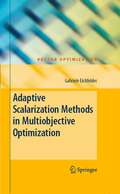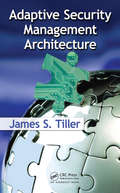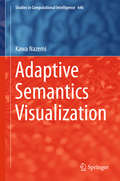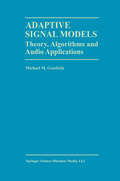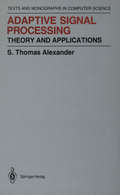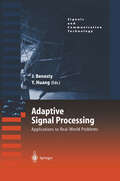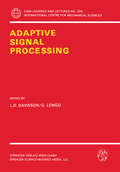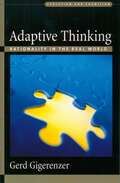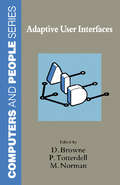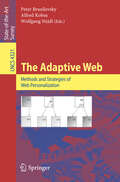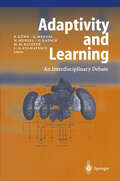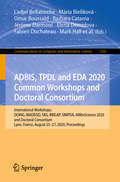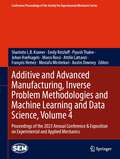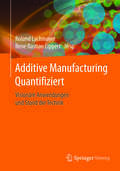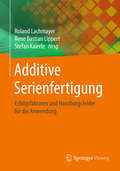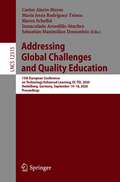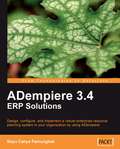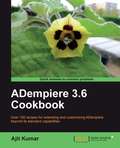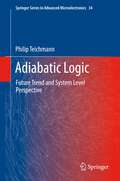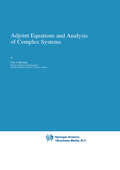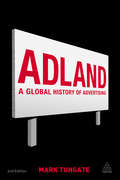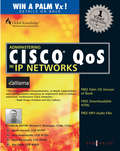- Table View
- List View
Adaptive Scalarization Methods in Multiobjective Optimization (Vector Optimization)
by Gabriele EichfelderAdaptive Security Management Architecture
by James S. TillerThis volume enables security professionals to structure the best security program designed to meet the complex needs of an entire organization, taking into account the organization's business goals as well as the surrounding controls, processes, and units already in existence. The book explains how an organization can develop an adaptive security program closely aligned to business needs, making it an enabling force that helps the organization achieve its goals and objectives. It presents the end product of a successful security management system and examines the finer points of how it can be accomplished.
Adaptive Security Management Architecture
by James S. TillerThis volume enables security professionals to structure the best security program designed to meet the complex needs of an entire organization, taking into account the organization's business goals as well as the surrounding controls, processes, and units already in existence. The book explains how an organization can develop an adaptive security program closely aligned to business needs, making it an enabling force that helps the organization achieve its goals and objectives. It presents the end product of a successful security management system and examines the finer points of how it can be accomplished.
Adaptive Semantics Visualization (Studies in Computational Intelligence #646)
by Kawa NazemiThis book introduces a novel approach for intelligent visualizations that adapts the different visual variables and data processing to human’s behavior and given tasks. Thereby a number of new algorithms and methods are introduced to satisfy the human need of information and knowledge and enable a usable and attractive way of information acquisition. Each method and algorithm is illustrated in a replicable way to enable the reproduction of the entire “SemaVis” system or parts of it. The introduced evaluation is scientifically well-designed and performed with more than enough participants to validate the benefits of the methods. Beside the introduced new approaches and algorithms, readers may find a sophisticated literature review in Information Visualization and Visual Analytics, Semantics and information extraction, and intelligent and adaptive systems. This book is based on an awarded and distinguished doctoral thesis in computer science.
Adaptive Signal Models: Theory, Algorithms, and Audio Applications (The Springer International Series in Engineering and Computer Science #467)
by Michael M. GoodwinAdaptive Signal Models: Theory, Algorithms and Audio Applications presents methods for deriving mathematical models of natural signals. The introduction covers the fundamentals of analysis-synthesis systems and signal representations. Some of the topics in the introduction include perfect and near-perfect reconstruction, the distinction between parametric and nonparametric methods, the role of compaction in signal modeling, basic and overcomplete signal expansions, and time-frequency resolution issues. These topics arise throughout the book as do a number of other topics such as filter banks and multiresolution. The second chapter gives a detailed development of the sinusoidal model as a parametric extension of the short-time Fourier transform. This leads to multiresolution sinusoidal modeling techniques in Chapter Three, where wavelet-like approaches are merged with the sinusoidal model to yield improved models. In Chapter Four, the analysis-synthesis residual is considered; for realistic synthesis, the residual must be separately modeled after coherent components (such as sinusoids) are removed. The residual modeling approach is based on psychoacoustically motivated nonuniform filter banks. Chapter Five deals with pitch-synchronous versions of both the wavelet and the Fourier transform; these allow for compact models of pseudo-periodic signals. Chapter Six discusses recent algorithms for deriving signal representations based on time-frequency atoms; primarily, the matching pursuit algorithm is reviewed and extended. The signal models discussed in the book are compact, adaptive, parametric, time-frequency representations that are useful for analysis, coding, modification, and synthesis of natural signals such as audio. The models are all interpreted as methods for decomposing a signal in terms of fundamental time-frequency atoms; these interpretations, as well as the adaptive and parametric natures of the models, serve to link the various methods dealt with in the text. Adaptive Signal Models: Theory, Algorithms and Audio Applications serves as an excellent reference for researchers of signal processing and may be used as a text for advanced courses on the topic.
Adaptive Signal Processing: Theory and Applications (Monographs in Computer Science)
by Thomas S. AlexanderThe creation of the text really began in 1976 with the author being involved with a group of researchers at Stanford University and the Naval Ocean Systems Center, San Diego. At that time, adaptive techniques were more laboratory (and mental) curiosities than the accepted and pervasive categories of signal processing that they have become. Over the lasl 10 years, adaptive filters have become standard components in telephony, data communications, and signal detection and tracking systems. Their use and consumer acceptance will undoubtedly only increase in the future. The mathematical principles underlying adaptive signal processing were initially fascinating and were my first experience in seeing applied mathematics work for a paycheck. Since that time, the application of even more advanced mathematical techniques have kept the area of adaptive signal processing as exciting as those initial days. The text seeks to be a bridge between the open literature in the professional journals, which is usually quite concentrated, concise, and advanced, and the graduate classroom and research environment where underlying principles are often more important.
Adaptive Signal Processing: Applications to Real-World Problems (Signals and Communication Technology)
by Jacob Benesty Yiteng HuangFor the first time, a reference on the most relevant applications of adaptive filtering techniques. Top researchers in the field contributed chapters addressing applications in acoustics, speech, wireless and networking, where research is still very active and open.
Adaptive Signal Processing (CISM International Centre for Mechanical Sciences #324)
by L. D. Davisson G. LongoThe four chapters of this volume, written by prominent workers in the field of adaptive processing and linear prediction, address a variety of problems, ranging from adaptive source coding to autoregressive spectral estimation. The first chapter, by T.C. Butash and L.D. Davisson, formulates the performance of an adaptive linear predictor in a series of theorems, with and without the Gaussian assumption, under the hypothesis that its coefficients are derived from either the (single) observation sequence to be predicted (dependent case) or a second, statistically independent realisation (independent case). The contribution by H.V. Poor reviews three recently developed general methodologies for designing signal predictors under nonclassical operating conditions, namely the robust predictor, the high-speed Levinson modeling, and the approximate conditional mean nonlinear predictor. W. Wax presents the key concepts and techniques for detecting, localizing and beamforming multiple narrowband sources by passive sensor arrays. Special coding algorithms and techniques based on the use of linear prediction now permit high-quality voice reproduction at remorably low bit rates. The paper by A. Gersho reviews some of the main ideas underlying the algorithms of major interest today.
Adaptive Thinking: Rationality in the Real World (Evolution and Cognition)
by Gerd GigerenzerWhere do new ideas come from? What is social intelligence? Why do social scientists perform mindless statistical rituals? This vital book is about rethinking rationality as adaptive thinking: to understand how minds cope with their environments, both ecological and social. Gerd Gigerenzer proposes and illustrates a bold new research program that investigates the psychology of rationality, introducing the concepts of ecological, bounded, and social rationality. His path-breaking collection takes research on thinking, social intelligence, creativity, and decision-making out of an ethereal world where the laws of logic and probability reign, and places it into our real world of human behavior and interaction. Adaptive Thinking is accessibly written for general readers with an interest in psychology, cognitive science, economics, sociology, philosophy, artificial intelligence, and animal behavior. It also teaches a practical audience, such as physicians, AIDS counselors, and experts in criminal law, how to understand and communicate uncertainties and risks.
Adaptive User Interfaces
by Dermot BrowneThis book describes techniques for designing and building adaptive user interfaces developed in the large AID project undertaken by the contributors.Describes one of the few large-scale adaptive interface projects in the worldOutlines the principles of adaptivity in human-computer interaction
The Adaptive Web: Methods and Strategies of Web Personalization (Lecture Notes in Computer Science #4321)
by Peter Brusilovsky Alfred Kobsa Wolfgang NejdlThis state-of-the-art survey provides a systematic overview of the ideas and techniques of the adaptive Web and serves as a central source of information for researchers, practitioners, and students. The volume constitutes a comprehensive and carefully planned collection of chapters that map out the most important areas of the adaptive Web, each solicited from the experts and leaders in the field.
Adaptivity and Learning: An Interdisciplinary Debate
by Reimer Kühn Randolf Menzel Wolfram Menzel Ulrich Ratsch Michael M. Richter Ion-Olimpiu StamatescuAdaptivity and learning have in recent decades become a common concern of scientific disciplines. These issues have arisen in mathematics, physics, biology, informatics, economics, and other fields more or less simultaneously. The aim of this publication is the interdisciplinary discourse on the phenomenon of learning and adaptivity. Different perspectives are presented and compared to find fruitful concepts for the disciplines involved. The authors select problems showing representative traits concerning the frame up, the methods and the achievements rather than to present extended overviews.
ADBIS, TPDL and EDA 2020 Common Workshops and Doctoral Consortium: International Workshops: DOING, MADEISD, SKG, BBIGAP, SIMPDA, AIMinScience 2020 and Doctoral Consortium, Lyon, France, August 25–27, 2020, Proceedings (Communications in Computer and Information Science #1260)
by Ladjel Bellatreche Mária Bieliková Omar Boussaïd Barbara Catania Jérôme Darmont Elena Demidova Fabien Duchateau Mark Hall Tanja Merčun Boris Novikov Christos Papatheodorou Thomas Risse Oscar Romero Lucile Sautot Guilaine Talens Robert Wrembel Maja ŽumerThis book constitutes thoroughly reviewed and selected papers presented at Workshops and Doctoral Consortium of the 24th East-European Conference on Advances in Databases and Information Systems, ADBIS 2020, the 24th International Conference on Theory and Practice of Digital Libraries, TPDL 2020, and the 16th Workshop on Business Intelligence and Big Data, EDA 2020, held in August 2020. Due to the COVID-19 the joint conference and satellite events were held online. The 26 full papers and 5 short papers were carefully reviewed and selected from 56 submissions. This volume presents the papers that have been accepted for the following satellite events: Workshop on Intelligent Data - From Data to Knowledge, DOING 2020; Workshop on Modern Approaches in Data Engineering and Information System Design, MADEISD 2020; Workshop on Scientic Knowledge Graphs, SKG 2020; Workshop of BI & Big Data Applications, BBIGAP 2020; International Symposium on Data-Driven Process Discovery and Analysis, SIMPDA 2020; International Workshop on Assessing Impact and Merit in Science, AIMinScience 2020; Doctoral Consortium.
Additive and Advanced Manufacturing, Inverse Problem Methodologies and Machine Learning and Data Science, Volume 4: Proceedings of the 2023 Annual Conference & Exposition on Experimental and Applied Mechanics (Conference Proceedings of the Society for Experimental Mechanics Series)
by Sharlotte L. B. Kramer Emily Retzlaff Piyush Thakre Johan Hoefnagels Marco Rossi Attilio Lattanzi François Hemez Mostafa Mirshekari Austin DowneyAdditive and Advanced Manufacturing, Inverse Problem Methodologies and Machine Learning and Data Science, Volume 4 of the Proceedings of the 2023 SEM Annual Conference & Exposition on Experimental and Applied Mechanics, the fourth volume of five from the Conference, brings together contributions to this important area of research and engineering. The collection presents early findings and case studies on a wide range of topics and includes papers in the following general technical research areas: AM Composites and Polymers Dynamic Behavior of Additively Manufactured Materials and Structures Joint Residual Stress and Additive Manufacturing ML for Material Model Identification Novel AM Structures Novel Processing and Testing of Additively Manufactured Materials Plasticity and Complex Material Behavior Virtual Fields Method
Additive Manufacturing Quantifiziert: Visionäre Anwendungen und Stand der Technik
by Roland Lachmayer Rene Bastian LippertDieses Buch zeigt Untersuchungen verschiedener Additive Manufacturing Technologien für den industriellen Einsatz. Aus Sicht der Produktentwicklung werden Aspekte zur Beeinflussung der Wertschöpfungskette, technische und wirtschaftliche Einflussfaktoren für die industrielle Anwendung sowie Konfektionierungs- und Nachbearbeitungsprozesse zur Verbesserung der Bauteilqualität spezifiziert. Zur Evaluation der Einsatzpotentiale werden weiterhin Methoden und Werkzeuge für die Bauteilgestaltung sowie zur Prozessanalyse und -optimierung dargestellt. Die Realisierung geänderter Gestaltungsziele, wie beispielsweise die Herstellung von Ultra-Leichtbau-Komponenten, wird ferner durch den Einsatz neuer Werkstoffe analysiert. Anhand diverser Fallstudien aus Forschung und Industrie werden aktuelle Einsatzgebiete des Additive Manufacturing dargestellt sowie künftige Entwicklungen für den Praxiseinsatz beschrieben.
Additive Manufacturing with Metals: Design, Processes, Materials, Quality Assurance, and Applications
by Sanjay Joshi Richard P. Martukanitz Abdalla R. Nassar Pan MichalerisThis textbook and reference provides a comprehensive treatment of additive manufacturing (AM) for metals, including design and digital work flows, process science and reliability, metallic systems, quality assurance, and applications. The book is rooted in the fundamental science necessary to develop and understand AM technologies, as well as the application of engineering principles covering several disciplines to successfully exploit this important technology. As additive manufacturing of metals is the fastest growing subset of this transformative technology, with the potential to make the widest impact to industrial production, Metals Additive Manufacturing: Design, Processes, Materials, Quality Assurance, and Applications is ideal for students in a range of engineering disciplines and practitioners working in aerospace, automotive, medical device manufacturing industries.
Additive Serienfertigung: Erfolgsfaktoren und Handlungsfelder für die Anwendung
by Roland Lachmayer Rene Bastian Lippert Stefan KaierleBei der additiven Fertigung wird anders als bei konventionellen Verfahren ein Bauteil nicht aus einem Block herausgefräst oder in einem Werkzeug gegossen, sondern es wird Schicht für Schicht generiert. Dieses Buch stellt eine Vielzahl verschiedener Aspekte der additiven Fertigung vor und erläutert anhand von Praxisbeispielen die Anwendungen und die Potenziale der Verfahren für eine Serienfertigung: Wo und wie kann die additive Fertigung erfolgreich eingesetzt werden?Die Autoren zeigen vor dem Hintergrund eines ganzheitlichen Entwicklungs- und Fertigungsprozesses mögliche Geschäftsmodelle auf, unter anderem die Fertigung in Microfactories. Leser erfahren, wie sich die Fertigungszeit und -kosten vorhersagen lassen, wie zuverlässig additiv gefertigte Strukturbauteile sind und inwieweit additive Fertigungsverfahren für die Herstellung von Endprodukten geeignet sind.Ferner diskutieren die Autoren, wie Pre- und Post-Prozesse genutzt werden können, um Serienanwendungen zu etablieren und diese iterativ zu verbessern. Neben den Möglichkeiten zur Qualitätssicherung bei der additiven Serienfertigung wird erläutert, wann es sinnvoll sein kann, konventionelle Fertigungsverfahren durch hybride Ansätze zu ergänzen. Die additive Instandsetzung als Alternative zum Entsorgen von verschlissenen Bauteilen wird ebenfalls erörtert. Im Hinblick auf eine Effizienzsteigerung diskutieren die Autoren Sicherheitsaspekte und legen Lösungsansätze bei Problemen im Umgang mit der additiven Serienfertigung dar.
Addressing Global Challenges and Quality Education: 15th European Conference on Technology Enhanced Learning, EC-TEL 2020, Heidelberg, Germany, September 14–18, 2020, Proceedings (Lecture Notes in Computer Science #12315)
by Maren Scheffel María Jesús Rodríguez-Triana Carlos Alario-Hoyos Inmaculada Arnedillo-Sánchez Sebastian Maximilian DennerleinThis book constitutes the proceedings of the 15th European Conference on Technology Enhanced Learning, EC-TEL 2020, held in Heidelberg, Germany, in September 2020. The 24 research papers and 20 demo and 5 poster papers presented in this volume were carefully reviewed and selected from 91 submissions. The European Conference on Technology-Enhance Learning, which celebrates its 15th anniversary this year, is committed to address global challenges and quality education. The papers deal with the Sustainable Development Goals, particularly SDG 4 and SDG 10, to help to reduce the existing gaps and inequalities between countries and regions from around the world in terms of inclusiveness, equity, access, and quality of education.The chapters: “Designing an Online Self-Assessment for Informed Study Decisions: The User Perspective”; “Living with Learning Difficulties: Two Case Studies Exploring the Relationship Between Emotion and Performance in Students With Learning Difficulties”; “Applying Instructional Design Principles on Augmented Reality Cards for Computer Science Education”; and “Teaching Simulation Literacy With Evacuations - Concept, Technology, and Material for a Novel Approach” are available open access under a Creative Commons Attribution 4.0 International License via link.springer.com. Due to the Corona pandemic EC-TEL 2020 was held as an virtual event.
ADempiere 3.4 ERP Solutions: Design Configure, And Implement A Robust Enterprise Resource Planning System In Your Organization By Using Adempiere
by Bayu Cahya PamungkasThis book is an easy-to-follow tutorial that will show you how to install and implement ADempiere. You will be shown how to set-up and use the features of ADempiere through plenty of step-by-step instructions with lots of examples and screenshots, and you will have a feature-rich, working version of ADempiere by the end of the book. If you want to easily implement ADempiere in your organization, this book is for you. This book will also be beneficial to system users and administrators who wish to implement an ERP system. No previous knowledge of ADempiere is required. A basic knowledge of accounting and the standard business workflow would be beneficial.
Adiabatic Logic: Future Trend and System Level Perspective (Springer Series in Advanced Microelectronics #34)
by Philip TeichmannAdiabatic logic is a potential successor for static CMOS circuit design when it comes to ultra-low-power energy consumption. Future development like the evolutionary shrinking of the minimum feature size as well as revolutionary novel transistor concepts will change the gate level savings gained by adiabatic logic. In addition, the impact of worsening degradation effects has to be considered in the design of adiabatic circuits. The impact of the technology trends on the figures of merit of adiabatic logic, energy saving potential and optimum operating frequency, are investigated, as well as degradation related issues. Adiabatic logic benefits from future devices, is not susceptible to Hot Carrier Injection, and shows less impact of Bias Temperature Instability than static CMOS circuits. Major interest also lies on the efficient generation of the applied power-clock signal. This oscillating power supply can be used to save energy in short idle times by disconnecting circuits. An efficient way to generate the power-clock is by means of the synchronous 2N2P LC oscillator, which is also robust with respect to pattern-induced capacitive variations. An easy to implement but powerful power-clock gating supplement is proposed by gating the synchronization signals. Diverse implementations to shut down the system are presented and rated for their applicability and other aspects like energy reduction capability and data retention. Advantageous usage of adiabatic logic requires compact and efficient arithmetic structures. A broad variety of adder structures and a Coordinate Rotation Digital Computer are compared and rated according to energy consumption and area usage, and the resulting energy saving potential against static CMOS proves the ultra-low-power capability of adiabatic logic. In the end, a new circuit topology has to compete with static CMOS also in productivity. On a 130nm test chip, a large scale test vehicle containing an FIR filter was implemented in adiabatic logic, utilizing a standard, library-based design flow, fabricated, measured and compared to simulations of a static CMOS counterpart, with measured saving factors compliant to the values gained by simulation. This leads to the conclusion that adiabatic logic is ready for productive design due to compatibility not only to CMOS technology, but also to electronic design automation (EDA) tools developed for static CMOS system design.
Adjoint Equations and Analysis of Complex Systems (Mathematics and Its Applications #295)
by Guri I. MarchukNew statements of problems arose recently demanding thorough ana lysis. Notice, first of all, the statements of problems using adjoint equations which gradually became part of our life. Adjoint equations are capable to bring fresh ideas to various problems of new technology based on linear and nonlinear processes. They became part of golden fund of science through quantum mechanics, theory of nuclear reactors, optimal control, and finally helped in solving many problems on the basis of perturbation method and sensitivity theory. To emphasize the important role of adjoint problems in science one should mention four-dimensional analysis problem and solution of inverse problems. This range of problems includes first of all problems of global climate changes on our planet, state of environment and protection of environ ment against pollution, preservation of the biosphere in conditions of vigorous growth of population, intensive development of industry, and many others. All this required complex study of large systems: interac tion between the atmosphere and oceans and continents in the theory of climate, cenoses in the biosphere affected by pollution of natural and anthropogenic origin. Problems of local and global perturbations and models sensitivity to input data join into common complex system.
Adland: A Global History of Advertising
by Mark TungateAdland is a ground-breaking examination of modern advertising, from its origins and evolution to the current advertising landscape. Bestselling author and journalist Mark Tungate examines key developments in advertising, from copy adverts, radio and television, to the opportunities afforded by the explosion of digital media and then interviews leading names in advertising today, including Jean-Marie Dru, Sir Alan Parker, Sir John Hegarty and Sir Martin Sorrell, as well as 20th century industry luminaries such as Phil Dusenberry and George Lois.Exploring the roots of the advertising industry in New York and London, from Hopkins and Lasker to the Mad Men of the 50s, Tungate then covers today's big communication groups and the emerging markets of Eastern Europe, Asia and Latin America. Adland offers a comprehensive examination of a global industry and suggests ways in which it is likely to develop in the future.
Adland: A Global History of Advertising
by Mark TungateAdland is a ground-breaking examination of modern advertising, from its origins and evolution to the current advertising landscape. Bestselling author and journalist Mark Tungate examines key developments in advertising, from copy adverts, radio and television, to the opportunities afforded by the explosion of digital media and then interviews leading names in advertising today, including Jean-Marie Dru, Sir Alan Parker, Sir John Hegarty and Sir Martin Sorrell, as well as 20th century industry luminaries such as Phil Dusenberry and George Lois.Exploring the roots of the advertising industry in New York and London, from Hopkins and Lasker to the Mad Men of the 50s, Tungate then covers today's big communication groups and the emerging markets of Eastern Europe, Asia and Latin America. Adland offers a comprehensive examination of a global industry and suggests ways in which it is likely to develop in the future.
Administering Cisco QoS in IP Networks: Including CallManager 3.0, QoS, and uOne (The Callisma Convergence Networking Series)
by SyngressAVVID (Architecture for Voice, Video, and Integrated Data), the latest development from Cisco Systems is redefining the way businesses communicate. AVVID allows businesses to transmit voice, data, and video over a single integrated architecture, whereas in the past three separate systems were required.Administering Cisco AVVID Applications is a professional reference detailing the strategies, tactics, and methods for utilizing Cisco software to configure and maintain Cisco networks and hardware infrastructures. It includes thorough discussions of critical topics such as, Cisco CallManager Version 3.0, Cisco Unified Open Network Exchange 4.1E (uOne), WebLine and GeoTel product software, Cisco QoS Policy Manger 1.1 as well as many other QoS features, and Cisco IOS network-wide software.* Allows IP professional to get ahead in this growing field* Demand for engineers and administrators who understand the specifics of the Cisco AVVID is growing quickly - this book has the answers
